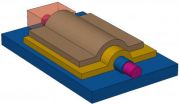(Press-News.org) A class of decorative, flower-like defects in the nanomaterial graphene could have potentially important effects on the material's already unique electrical and mechanical properties, according to researchers at the National Institute of Standards and Technology (NIST) and Georgia Tech. In a new paper,* the team for the first time describes a family of seven defects that could occur naturally or be induced to occur in graphene, one of which already has been observed.
Graphene is renowned for its strength and conductivity, both of which are a result of its structure. For the most part, graphene is a featureless plane of carbon atoms arranged in a honeycomb lattice.
According to NIST Fellow Joseph Stroscio, defects can appear due to the movement of the carbon atoms at high temperatures when producing graphene by heating silicon carbide under ultrahigh vacuum. The easiest, i.e. requiring the least amount of energy, rearrangements graphene can make are to switch from six-member carbon rings to rings containing five or seven atoms, which keeps all the carbon atoms happy with no unsatisfied bonds. The NIST researchers have discovered that stringing five and seven member rings together in closed loops creates a new type of defect or grain boundary loop in the honeycomb lattice.
According to NIST researcher Eric Cockayne, the fabrication process plays a big role in creating these defects.
"As the graphene forms under high heat, sections of the lattice can come loose and rotate," Cockayne says. "As the graphene cools, these rotated sections link back up with the lattice, but in an irregular way. It's almost as if patches of the graphene were cut out with scissors, turned clockwise, and made to fit back into the same place, only it really doesn't fit, which is why we get these flowers."
The exceedingly rigid lattice already is stronger than steel, but the defects might allow it a little flexibility, making it even more resilient to tearing or fracturing.
With more experimentation, Cockayne says, researchers should be able to correlate the appearance of defects with variations in growth conditions, which should make it possible to either avoid defects entirely or produce them at will.
Moreover, while the flower defect is composed of six pairs of five- and seven-atom rings, Cockayne and the NIST team's modeling of graphene's atomic structure suggests there might be a veritable bouquet of flower-like configurations. These configurations—seven in all—would each possess their own unique mechanical and electrical properties.
INFORMATION:
* E. Cockayne, G. Rutter, N. Guisinger, J. Crain, P. First and J. Stroscio. Grain boundary loops in graphene. Physical Review B. 83, 195425 (2011). DOI: 10.1103/PhysRevB.83.195425
Defect in graphene may present bouquet of possibilities
2011-05-26
ELSE PRESS RELEASES FROM THIS DATE:
New software tool helps evaluate natural cooling options for buildings
2011-05-26
A new, free software tool from the National Institute of Standards and Technology (NIST) could prove to be a breath of fresh air for architects and designers of ventilation systems for "green" commercial buildings.
With the Climate Suitability Tool,* building design teams can evaluate whether the local climate is suitable for cooling a prospective building with natural ventilation or requires a hybrid system that supplies supplemental cooling capacity. The tool is based on a model of the heat-related characteristics of a building configured to take full advantage of ambient ...
NIST 'nanowire' measurements could improve computer memory
2011-05-26
A recent study* at the National Institute of Standards and Technology (NIST) may have revealed the optimal characteristics for a new type of computer memory now under development. The work, performed in collaboration with researchers from George Mason University (GMU), aims to optimize nanowire-based charge-trapping memory devices, potentially illuminating the path to creating portable computers and cell phones that can operate for days between charging sessions.
The nascent technology is based on silicon formed into tiny wires, approximately 20 nanometers in diameter. ...
Fish species discovered by LSU researcher makes 2011 top 10 list
2011-05-26
BATON ROUGE – The International Institute for Species Exploration at Arizona State University and a committee of taxonomists from around the world announced their picks for the top 10 new species described in 2010. Among their top picks is Halieutichthys intermedius, a pancake batfish recently discovered by Prosanta Chakrabarty, curator of fishes at LSU's Museum of Natural Science, and colleagues.
Halieutichthys intermedius, more commonly referred to as the Louisiana pancake batfish, gained some notoriety during the spring and summer of 2010, when the Deepwater Horizon ...
Public universities place greater focus on internal research services than public ones do
2011-05-26
Research expenditure has increased in Spain, as has the focus on research performance. However, the internal services that universities provide to support research, both in terms of infrastructure and staff, have not improved, according to a study published in the journal The Service Industries Journal, which also shows that public universities outperform private ones in this respect.
"The Ministry of Science and Innovation provides Spanish universities with access to databases. However, we have seen that in many cases there are no research support staff to explain how ...
New study provides global analysis of seagrass extinction risk
2011-05-26
A team of 21 researchers from 11 nations, including professor Robert "JJ" Orth of the Virginia Institute of Marine Science, has completed the first-ever study of the risk of extinction for individual seagrass species around the world.
The 4-year study, requested by the International Union for the Conservation of Nature (IUCN), shows that 10 of the 72 known seagrass species (14%) are at an elevated risk of extinction, while 3 species qualify as endangered.
The authors caution that loss of seagrass species and seagrass biodiversity will seriously impact marine ecosystems ...
Improved prognosis for esophageal cancer
2011-05-26
In recent years, the number of cases of adenocarcinoma of the esophagus (or gullet) has been on the rise. At the same time, however, new ways of treatment are improving the outlook for patients. In the current issue of Deutsches Ärzteblatt International (Dtsch Artzebl Int 2011; 108[18]: 313), Angelika Behrens and her working group report on innovations in diagnosis and treatment.
The main cause of this cancer is reflux of gastric acid from the stomach, with heartburn as the main symptom. Other risk factors are being male, being overweight, and having relatives ...
New bandwidth management techniques boost operating efficiency in multi-core chips
2011-05-26
Researchers from North Carolina State University have developed two new techniques to help maximize the performance of multi-core computer chips by allowing them to retrieve data more efficiently, which boosts chip performance by 10 to 40 percent.
To do this, the new techniques allow multi-core chips to deal with two things more efficiently: allocating bandwidth and "prefetching" data.
Multi-core chips are supposed to make our computers run faster. Each core on a chip is its own central processing unit, or computer brain. However, there are things that can slow these ...
Global warming may affect the capacity of trees to store carbon, MBL study finds
2011-05-26
MBL, WOODS HOLE, MASS.—One helpful action anyone can take in response to global warming is to plant trees and preserve forests. Trees and plants capture carbon dioxide during photosynthesis, thereby removing the most abundant greenhouse gas from the atmosphere and storing some of it in their woody tissue.
Yet global warming may affect the capacity of trees to store carbon by altering forest nitrogen cycling, concludes a study led by Jerry Melillo, Distinguished Scientist at the Marine Biological Laboratory (MBL) Ecosystems Center, and published this week in Proceedings ...
New Canadian blood pressure education program a powerful tool in fight to reduce stroke
2011-05-26
(Toronto, May 25, 2011): High blood pressure – the silent killer – is taking a hit from a new, ground-breaking treatment program from the Heart and Stroke Foundation of Ontario.
Last Sunday, in New York City, Dr. Sheldon Tobe, Chair of the Canadian Hypertension Education Program (CHEP) and a long-standing Heart and Stroke Foundation researcher, unveiled a new and powerful tool in the management of hypertension at the American Society of Hypertension (ASH) Scientific Meeting —The Heart&Stroke Hypertension Management Program.
"Diagnosing high blood pressure (hypertension) ...
2020 vision of vaccines for malaria, TB and HIV/AIDS
2011-05-26
SEATTLE, WA, May 25, 2011 – Collectively, malaria, TB & HIV/AIDS cause more than five million deaths per year – nearly the entire population of the state of Washington – and represent one of the world's major public health challenges as we move into the second decade of the 21st century. In the May 26, 2011, edition of the premier scientific journal Nature, Seattle BioMed Director Alan Aderem, Ph.D., along with Rino Rappuoli, Ph.D., Global Head of Vaccines Research for Novartis Vaccines & Diagnostics, discuss recent advances in vaccine development, along with new tools ...




